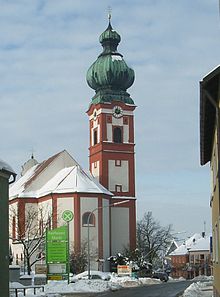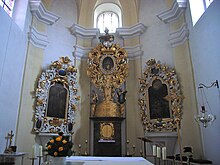Assumption of Mary (Eslarn)
The Church of the Assumption of Mary is the Roman Catholic parish church of Eslarn in the Upper Palatinate district of Neustadt an der Waldnaab ( Bavaria ).
history
The parish Eslarn was first mentioned in writing in 1326. Eslarn was Protestant from 1550 to 1625. In 1603 there was a dilapidated church that was completely destroyed in the Thirty Years War . In 1681 the construction of a new church was approved, which was completed and consecrated in 1689. The builder Johann Kirchberger from Neustadt an der Waldnaab was in charge of the construction .
Building
Originally, when the new church was built, the west tower was taken over from the old church. It was replaced in 1722 by a tower north of the choir. The tower was badly damaged in a fire in 1895 and the baroque high altar burned down. In 1910 the two outer stair turrets were added under the direction of architect Hauberisser. In 1927 the tower was given an onion dome . The red and white paint on the outside of the church comes from a renovation in 1967/69. The Eslarner Church is a baroque hall church . It is a pillared church in which the pillars protrude from the walls and thus divide the long side walls into chapels. In the side chapels are galleries confiscated. On the vault was from money reasons stucco waived and paintings.
Interior
High altar
The current (2013) installation of the interior was created during the renovation in 1967. The altar of grace in the middle is an acanthus altar typical of the Upper Palatinate from around 1700. It contains a Gothic statue of the Virgin Mary with a baby Jesus, framed by silver roses . A large crown hovers over the Madonna . At the top of the altar is a bearded God the Father figure with a globe and a dove of the Holy Spirit. On the left side of the altar is St. Joseph with a carpenter's saw and on the right side St. Joachim with two sacrificial pigeons. To the left and right of the altar of grace there are two more acanthus altars. They were donated in 1725. The left side altar depicts the crucifixion of Christ , the right the Pentecost event . A rosary Madonna from around 1700 hangs in front of the choir arch . The rosary was renewed in 1916. On the left wall of the choir arch there is a baroque Madonna.
Side altars
The four altars in the chapels of the nave represent John the Baptist in the desert with Saint Lawrence and Saint Stephen , Saint Anne teaching her daughter Maria to read, Saint Sebastian and Saint Francis Xavier , Saint Sebastian with them the St. Leonard and St. Nepomuk and the St. Joseph with the St. Roch and St. Florian . the paintings and the sculpture of St. Joseph arose early 18th century and the sculpture of St. Sebastian in the 16th century.
Pulpit and organ
The pulpit in 1759 and the organ prospectus in 1757 were made by Peter Bacher and Peter Hirsch from Amberg. The pulpit is a rococo wood carving . At the pulpit are the figures of the four evangelists Matthew , Mark , Luke and John . Between them are small reliefs of biblical scenes: the calming of the storm on the Sea of Galilee and the parables of the Sower and the Good Shepherd . On the back wall of the pulpit are angels with the cross of Christ and the tablets of the law . The pulpit lid is decorated with putti in the shape of the four continents . On the pulpit lid there is a figure of the Apostle Paul .
Guild poles
On both sides of the aisle there are guild poles from the 18th century, each with a candlestick angel bearing the coat of arms of a guild . The Eslarner craftsmen organized themselves into guilds since the 16th century. The oldest guild statute dates from 1543 and concerns the tailors from Eslarn, Moosbach and Waidhaus . This was followed in 1631 by craft regulations for the white bakers from Moosbach, Waidhaus, Burgtreswitz and Eslarn, 1677 for the bricklayers and carpenters from Tännesberg , Moosbach and Eslarn, 1710 for the cloth makers from Tännesberg, Moosbach and Eslarn and 1772 for the Eslarner millers, butchers, bakers, Shoemakers, tailors, weavers, bricklayers, carpenters, wagons, blacksmiths, locksmiths, joiners, glaziers and binders .
The guild poles in the Eslarner church are 14 so-called angel poles. They carry a standing or kneeling angel figure, which holds a relatively large candlestick in one hand and a sign with the symbols of the respective craft in the other hand. For each craft there are two angel poles with similar angels looking at each other. The angels of the various crafts look different in shape, color and expression. Two representatives of a craft carried these poles at the same height on the right and left side of the procession. The bricklayers, bakers, wagons, locksmiths, blacksmiths and butchers have female kneeling angels, the joiners have female standing angels and the carpenters have male standing angels. While the female angels wear long robes, the male angels are naked with a red and gold cloth around their hips. The Eslarner guild poles probably originated at the end of the 18th century. The artist who created them is unknown. They were carried in processions until the beginning of the 20th century.
Baptismal font
The baptismal font lid bears a plastic representation of the baptism of Jesus and a votive image with the coronation of Mary , St. Leonhard and St. Wendelin from 1743.
See also
literature
- Hans Schlemmer: History of the Eslarn Market. Book and offset printing Spintler Weiden, Regensburg 1960.
- Fränkischer Albverein (Ed.): On the Jakobsweg from Tillyschanz via Schwandorf to Nuremberg. Verlag Seehars, Uffenheim 1997, ISBN 3-927598-22-4 .
Web links
Individual evidence
- ↑ a b Manfred Müller (Ed.): Register of the diocese of Regensburg. Verlag des Bischöflichen Ordinariats Regensburg, 1997, p. 161
- ^ Fränkischer Albverein (Ed.): On the Way of St. James from Tillyschanz via Schwandorf to Nuremberg. Verlag Seehars, Uffenheim 1997, ISBN 3-927598-22-4 , p. 11
- ^ Fränkischer Albverein (Ed.): On the Way of St. James from Tillyschanz via Schwandorf to Nuremberg. Verlag Seehars, Uffenheim 1997, ISBN 3-927598-22-4 , pp. 11, 12
- ^ Fränkischer Albverein (Ed.): On the Way of St. James from Tillyschanz via Schwandorf to Nuremberg. Verlag Seehars, Uffenheim 1997, ISBN 3-927598-22-4 , p. 13
- ↑ a b c Fränkischer Albverein (Ed.): On the Jakobsweg from Tillyschanz via Schwandorf to Nuremberg. Verlag Seehars, Uffenheim 1997, ISBN 3-927598-22-4 , p. 14
- ↑ Horst Lambel: Guild poles in the northern Upper Palatinate . , Kreishandwerkerschaft Nordoberpfalz (ed.), Sprintler - Medienhaus Weiden 2000, pp. 30–37.
- ↑ Hans Schlemmer: History of the Eslarn market. Book and offset printing Spintler Weiden, Regensburg, 1960, pp. 97, 98
- ^ Fränkischer Albverein (Ed.): On the Way of St. James from Tillyschanz via Schwandorf to Nuremberg. Verlag Seehars, Uffenheim 1997, ISBN 3-927598-22-4 , p. 15
Coordinates: 49 ° 34 ′ 56.1 ″ N , 12 ° 31 ′ 15.4 ″ E




